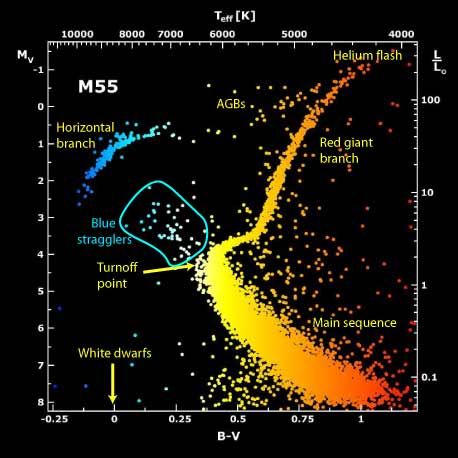Nebula. Collapse. Protostar. Main Sequence. Red Giant. Planetary Nebula. White Dwarf. This is the cycle of life for a star like our Sun. By observing stars across the galaxy, we see snapshots of different points in a star’s life cycle. It’s the same with people; If you went for a walk in a city and observed people for a day, you would see every single stage of a person’s life: Infant, child, adolescent, youth, adult, middle aged, senior. How would you put them in order if you knew nothing about them? With people you might go up and ask them, but with stars we can only use light and computer models. Light can reveal the elements present in the star, and help us to determine where they generally fit in the timeline of the universe, since stars with heavier elements are generally younger. Computer models have simulated the birth and evolution of stars, and comparing the simulated stars to stars in the sky can give us a strong estimate of their ages.
We can also use logic to guide the work. Just like a bigger engine burning through fuel faster, a larger, hotter star will live a shorter life than a smaller, cooler star. So when we see big, blue stars, we shouldn’t expect them to last for very long. But there’s a problem. There is a class of bright, blue, massive stars called blue stragglers that look younger and brighter than they should based on their age. If they were younger they would have burnt out, but they are alive and well far beyond their expected lifespan.

For some globular clusters, blue stragglers can make up 25% of the cluster population. Naturally, if we see more stars in one particular stage of life, the stage either lasts a lot longer, or it’s something that a lot of stars will go through. Since blue stragglers are a special case of a star’s life cycle, understanding them is important if we want a complete picture of stellar evolution. So what is going on?

More than half of all stars are in binary systems. Believe it or not, our Sun is a rarity, and most systems have two or more stars orbiting one another. How do different configurations affect a star’s life?
In binary systems of stars, what often happens is one of the stars will age to the point where it swells up in size to become a red giant. Because the stars are so close, the tidal forces of the smaller star allow it to suck material off of the red giant. The red giant phase tends to last a couple of hundred million years, after which it sheds its outer layers and become a tiny white dwarf star. Usually the material leftover from a red giant as it shrinks down to become a white dwarf is left in a gorgeous cloud called a planetary nebula, but with a companion star, this leftover material is sucked up.
The result in a system like this is the red giant loses it’s extra mass and becomes a white dwarf, while the companion sucks up so much material it becomes larger and hotter – a blue straggler. A recent publication by a team of scientists led by Robert Mathieu, a professor of astronomy at the University of Wisconsin-Madison, confirms that about 2/3 of blue stragglers have a white dwarf companion.
It’s not easy to do since Blue stragglers are so big and bright while a white dwarf is so small and dim, but by seeing a periodic Doppler shift in the light of the star, it was clear that a companion was tugging on the blue straggler. To confirm it was a white dwarf, the researchers looked at the blue stragglers in ultraviolet light, and when they saw a peak of emission in far ultraviolet wavelengths, they knew they had found a telltale sign of a white dwarf star. This also gave a final piece to the puzzle. To be detectable, a white dwarf star must be relatively young, less than 300 Million years old, otherwise it would have lost enough energy to fade away. So not only did the blue stragglers form through this binary interaction, they formed very recently, and haven’t had time to explode as supernovae yet.
But what about the other third of blue stragglers without binaries? Well if you look at the environment of a globular cluster, it is one of the most densely pack groupings of stars in the universe. This makes collisions inevitable, so it seems likely that other blue stragglers are forming through collision and merger of two stars in the dense cluster. There is still work to be done, but we are slowly starting to understand where they come from.
“If scientists don’t know how the blue stragglers formed, they are in a poor position to understand how they will evolve and die,” says Gosnell, who is now a postdoctoral fellow at the University of Texas. “Of course, we still have a third of the blue stragglers to figure out. I think we also have some stellar collisions in there.”

I’d have to check with you here. Which is not something I often do!
I like reading a post that’ll make people think. Also, thanks for letting me to comment!
It’s a shame you don’t have a donate button! I’d certainly donate to this fantastic blog!
I guess for now i’ll settle for book-marking and adding your RSS feed to my
Google account. I look forward to brand new updates and will share this blog with my Facebook group.
Talk soon!
Thanks very much! I’m good with offering the content for free, so feel free to continue enjoying it! It’s helpful for my writing and I enjoy all things astronomy!